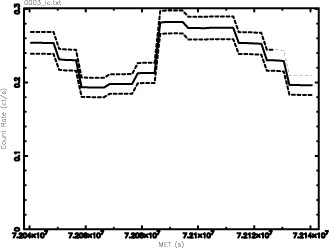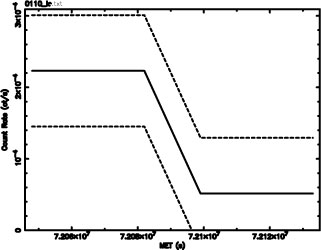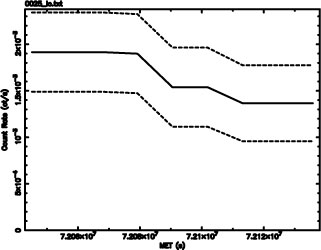
Introduction
We describe using the Gregory-Loredo
algorithm (Gregory & Loredo 1992) to detect temporal
variability in sources identified in the CXC L3 pipeline (Evans
et al. 2006), based on the event files. Briefly, N events are
binned in histograms of m bins, where m runs from 2 to mmax.
The algorithm is based on the likelihood of the observed
distribution n1 n2, ..., nm occurring. Out of a total number of
mN possible distributions
the multiplicity of this particular one is N!/(n1! . n2! . ... . nm!). The ratio of this multiplicity to
the total number provides the probability that this
distribution came about by chance. Hence the inverse is a
measure of the significance of the distribution. In this way
we calculate an odds ratio for m
bins versus a flat light curve. The odds are summed over all
values of m to determine the odds that the source
is time-variable.
The method works very well on event data and is capable to
deal with data gaps. We
have added the capability to take into account temporal
variations in effective area. As a byproduct, it delivers a
light curve with optimal resolution.
Although the algorithm was developed for detecting periodic
signals, it is a perfectly suitable method for detecting plain
variability by forcing the period to the length of the
observation.
We have implemented the G-L algorithm as a standard C program,
operating on simple ASCII files for ease of
experimentation. Input data consist of a list of event times
and, optionally, good time intervals with, optionally,
normalized effective area.
Two output files are created: odds
ratios as a function of m
and a light curve file.
If mmax is not explicitly specified, the
algorithm is run twice. The first time all values of
m are used, up to the minimum of 3000
and (te - tb) /50; i.e., variability is considered
for all time scales down to 50s, which is about 15 times the
most common ACIS frame time. The sum of odds S(m) = ∑ O(i) / (i - mmin + 1), where i = mmin ... m, is calculated as a function of
m and its maximum is determined. Then
the algorithm is run again with mmax set to the highest value of
m for which S(m) > max(S) / √e. In addition to the total odds
ratio O the corresponding probability
P of a variable signal is
calculated.
The
light curve that is generated by the program essentially
consists of the binnings weighed by their odds ratios and
represents the most optimal resolution for the curve. The
standard deviation σ is provided for each point of the
curve.
There is
an ambiguous range of probabilities: 0.5 < P < 0.9, and in particular the range between
0.5 and 0.67 (above 0.9 all is variable, below 0.5 all is
non-variable). For this range we have developed a secondary
criterion, based on the light curve, its average
σ, and the average count rate. We calculate the fractions
f3 and f5 of the light curve that are within
3σ and 5σ, respectively, of the average count rate. If
f3 > 0.997 AND f5 = 1.0 for cases in the ambiguous
probability range, the source is deemed to be
non-variable.
|
Variability
Index
|
Condition
|
Comment
|
|
0
|
0 < P <
0.5
|
Definitely not
variable
|
|
1
|
0.5 < P < 0.67
and f3 > 0.997 and f5 = 1.0 |
Not considered
variable
|
|
2
|
0.67 < P <
0.9
and f3 > 0.997 and f5 = 1.0 |
Probably not
variable
|
|
3
|
0.5 < P <
0.6
|
May be
variable
|
|
4
|
0.6 < P <
0.67
|
Likely to be
variable
|
|
5
|
0.67 < P <
0.9
|
Considered
variable
|
|
6
|
0.9 < P and O <
2.0
|
Considered
variable
|
|
7
|
2 < O < 4
|
Considered
variable
|
|
8
|
4 < O <
10
|
Considered
variable
|
|
9
|
10 < O <
30
|
Considered
variable
|
|
10
|
30 < O
|
Considered
variable
|

|
Odds ratio range
|
Probability range
|
Good
detections |
False
detections |
Missed with secondary criterion
|
False with secondary criterion
|
|
1.0 - 2.0
|
0.5 - 0.67
|
2
|
7
|
1
|
0
|
|
2.0 - 9.0
|
0.67 - 0.9
|
5
|
10
|
2
|
0
|
|
> 9.0
|
> 0.9
|
47
|
0
|
0
|
0
|


